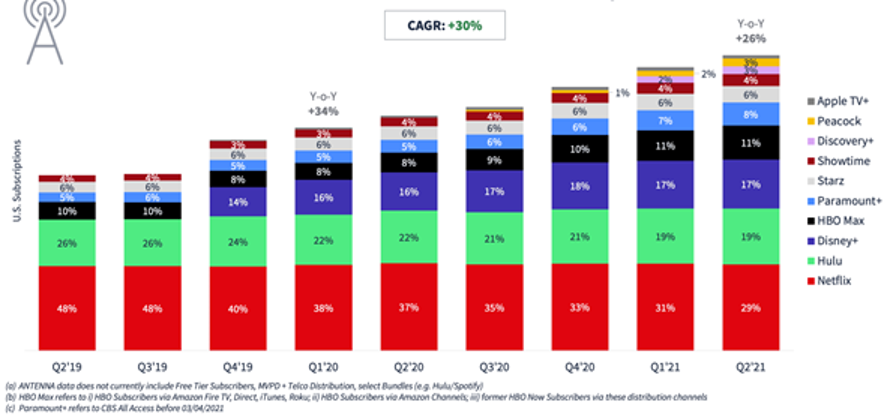By Kris Tait, Managing Director, Croud US
Every streaming service has the same goal: grow their audience. For brands like Netflix, Disney and Amazon, this is becoming an increasingly difficult and expensive challenge.
The established streaming players need to invest huge sums in creating new content to keep audiences watching (global content spend hit a record high of $220bn in 2020) – whilst also having to contend with rising CPAs (cost per acquisition) for new subscribers. To balance the books, this has caused services like Netflix to raise prices.
This has opened the door for competitors. Newer services like BritBox, HBO Max and discovery+ are able to swoop in and undercut the market with appealing offers. But there isn’t enough room in the budget for audiences to subscribe to every service, and with consumers spending an average of $47 a month on streaming services, getting a share of that wallet is tricky.

Big-budget, exclusive content that has large social status (hello, Squid Game) has certainly helped the major players build a strong lead in terms of subscribers. But the rapidly shifting landscape of the last 18 months has revealed some vulnerabilities.
Pandemic-induced production delays have forced a change to ‘original content’ strategies. Equally the pandemic has increased time spent streaming by 60%, meaning the need for more content has increased, but the capacity to deliver content that meets the needs of every customer is reduced. Privacy changes, specifically in the new iOS update, have also meant that it’s harder to see what marketing is working. Many brands are finding they are spending the same on media, but are seeing fewer conversions at a higher CPA. But reduce spend, and you are effectively shooting yourself in the foot.
Since their time working with BritBox North America, the team at Croud have developed four pillars to drive growth in this complex modern market.
Securing active demand
The first step is to ensure you are grabbing each and every piece of low-hanging-fruit by securing active demand.
This means actively acquiring people who are in the market for a service like BritBox, or who are actively searching and showing interest in a show you have. In this case, both audience and brand are actively looking for each-other, and so they should be the easiest to convert.
But you can waste money if you don’t get your targeting right. For BritBox, audience data from Google revealed huge inefficiencies in how certain keywords were being leveraged.

This graph highlights the extent of this opportunity. The Lost to Rank percentage indicates the opportunity to improve ad quality; ad copy, landing pages. So on the Show/Brand there was an enormous opportunity to improve campaigns.
Brands need to actively reassess their keywords and retargeting pools: how people search is constantly changing, and effectiveness comes from keeping your finger on the pulse of these changes. This doesn’t have to be a manual process however; there are a multitude of tools and products (within Google) that can automate and highlight these behaviours for you.
Capitalizing on latent demand
Another key segment to target are consumers who have been recommended a show they’d like to watch, but may have forgotten or it’s not top of mind. These audiences can be gently nudged into action.
There is one main question to ask here. What are people watching on the platform?
With this first-party data insight, you can quickly react by getting creative into the market. Then it is a case of tracking what types of shows ‘pop’. Understand who is engaging with what and why, and then use this insight to conjure even more effective creative.
By feeding first-party data into the marketing process, you can act swiftly to capture latent demand.
Generating demand
This is when things start to get more challenging; this requires creative and strategic approaches to prospecting new subscribers.
While you can reach a high portion of Americans on Facebook, generating new demand isn’t just as straightforward as dumping more money in this direction.
To unlock demand, you need the right combination of message and measurement. What are we putting to the market, and how is it landing? If you can clearly view these two points you can unlock additional scalability.
Working with BritBox, we leveraged causal analysis to establish the effectiveness of larger branded marketing efforts. This allowed us to understand how a TV ad influenced search behavior, website traffic and finally how many subscribers it delivered above the baseline.
Converting demand to action
The final pillar focuses on ensuring that, if we get audiences to visit our service, we are doing everything in our power to convert them.
Much is made of how easy it is to buy media in the modern digital marketplace, but not enough is made of how easy it is to mess it up if you don’t know what you are doing.
Converting demand into action is the most crucial phase. Streaming services invest a lot in getting people to their site, but they underspend on the actual on-site conversion. This isn’t about tricking people into converting: it is about engaging design and intelligent application of UX.
Streaming services must ensure that the value proposition is clear. With BritBox, we conducted A/B testing on landing pages that resulted in a 34% more effective conversion rate. These insights can be translated into landing pages for the latest shows, allowing streaming brands to develop increasingly effective templates.
Data is the most powerful weapon available to brands in the streaming wars. Combining strong measurement with curiosity and creativity will allow these brands to compete in this hyper competitive environment.








